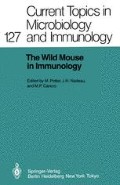Abstract
The most proximal portion of mouse chromosome 17 occurs in a variant form known as a t haplotyper which is present at a high frequency in wild populations of mus domesticus and mus musculus. While t haplotypes have been studied by a number of investigators over the last 50 years, it is only within the last 5 years that we have begun to appreciate the true nature of these unusual genetic elements (for a recent review, see Silver, 1986). A large body of new data from a number of laboratories indicates that all naturally occurring t haplotypes are closely related to each other with a characteristic genomic organization that differs from the wild-type organization of this chromosomal region. (The “wild-type chromosome 17” refers to the non-t-haplotype form normally found in mus domesticus or mus musculus). Within the structurally variant region that defines t haplotypes (approximately 20–30,000 kb of DNA encompassing the T locus and the entire MHC), are many normally functioning genes interspersed with a number of independent “mutant loci” that mediate the characteristic t haplotype effects on fertility and development.
Access this chapter
Tax calculation will be finalised at checkout
Purchases are for personal use only
Preview
Unable to display preview. Download preview PDF.
References
Fox H, Silver LM, Martin GR (1984) An alpha globin pseudogene is located within the mouse t complex. Immunogenetics 19:125–130
Fox H, Martin G, Lyon MF, Herrmann B, Frischauf A-M, Lehrach H, Silver LM (1985) Molecular probes define different regions of the t complex. Cell 40:63–69
Herrmann B, Bucan M, Mains P, Frischauf A-M, Silver LM, Lehrach H (1986) Analysis of the proximal portion of the mouse t complex: Evidence for a second inversion within t haplotypes. Cell, in press.
Lyon MF (1984) Transmission ratio distortion in mouse t-haplotypes is due to multiple distorter genes acting on a responder locus. Cell 37:621–628
Nizetic D, Figueroa F, Klein J (1984) Evolutionary relationships between the t and H-2 haplotypes in the house mouse. Immunogenetics 19:311–320
Olds-Clarke P, Peitz B (in press) Fertility of sperm from t/+ mice: Evidence that +-bearing sperm are dysfunctional. Genetical Research
Roehme D, Fox H, Herrmann B, Frischauf A-M, Edstrom J-E, Mains P, Silver LM, Lehrach H (1984) Molecular clones of the mouse t complex derived from microdissected metaphase chromosomes. Cell 36:783–788
Sarvetnick N, Mann E, Mains P, Elliott R, Silver LM (1986) Nonhomologous pairing in mouse t haplotype heterozygotes can produce recombinant chromosomes with adjacent duplications and deletions.
Shin H-S, Stavnezer J, Artzt Kf Bennett D (1982) The genetic structure and origin of t-haplotypes of mice, analysed with H-2 cDNA probes. Cell 29:969–976
Silver LM (1982) Genomic analysis of the H-2 complex region associated with mouse t haplotypes. Cell 29:961–968
Silver LM (1986) Mouse t haplotypes. Ann. Rev. Genet. 19:179–208
Silver LM, Olds-Clarke P (1984) Transmission ratio distortion of mouse t haplotypes is not a consequence of wild-type sperm degeneration. Develop. Biol. 105:250–252
Silver LM, Uman J, Danska J, Garrels JI (1983) A diversified set of testicular cell proteins specified by genes within the mouse t complex. Cell 35:35–45
Editor information
Editors and Affiliations
Rights and permissions
Copyright information
© 1986 Springer-Verlag Berlin · Heidelberg
About this paper
Cite this paper
Schimenti, J., Silver, L.M. (1986). Amplification and Rearrangement of DNA Sequences During the Evolutionary Divergence of t Haplotypes and Wild-Type Forms of Mouse Chromosome 17. In: Potter, M., Nadeau, J.H., Cancro, M.P. (eds) The Wild Mouse in Immunology. Current Topics in Microbiology and Immunology, vol 127. Springer, Berlin, Heidelberg. https://doi.org/10.1007/978-3-642-71304-0_28
Download citation
DOI: https://doi.org/10.1007/978-3-642-71304-0_28
Publisher Name: Springer, Berlin, Heidelberg
Print ISBN: 978-3-642-71306-4
Online ISBN: 978-3-642-71304-0
eBook Packages: Springer Book Archive

